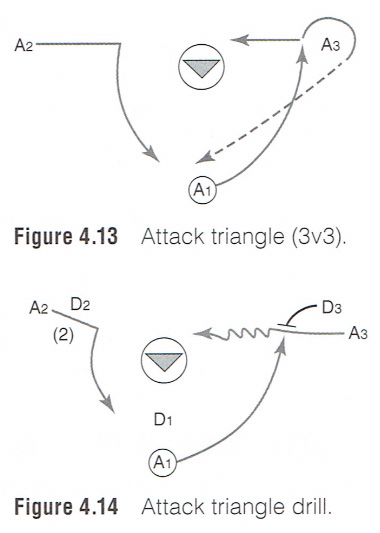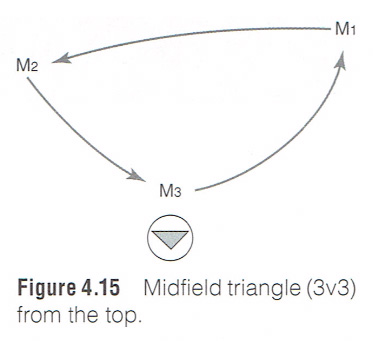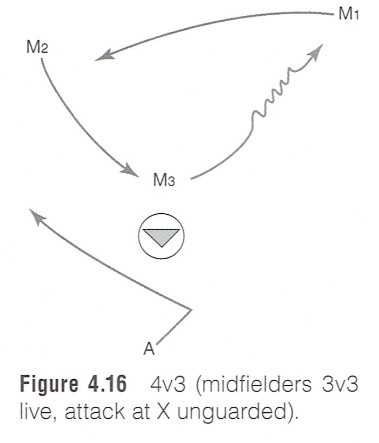| Motion Offense - Teaching the Triangles |
| By: Jack Kaley and Rich Donovan
Originally Published in: Lacrosse Essentials Provided by: Human Kinetics To teach motion offense and its concepts, begin with one triangle at a time. ATTACK TRIANGLE (3V3) For drill purposes, A1 starts with the ball and drives either side to initiate the rotation. He has two options: A3 on the backdoor cut or A2 at the offpipe. If neither option is open when the pointman carries the ball to the GLE, he rolls and throws back to the far wing attackman, who has come to the point (see figure 4.13).
When A1 drives the right side, his first option is to A3 going back door. If A3 is open, he slows his cut so that he can get a feed right on the crease. The second option for A1 is to the offside wing (A2), who should hang at the offside pipe before he rotates behind. If D2 slid in to pick up A3, A2 is open. If neither option is open, A1 turns and throws back to A2 at the point behind the cage. In a game situation, A1 has the option to dodge. In the attack triangle drill, players coordinate their timing, spacing, and passing (see figure 4.14). If players understand the concept, when the attackman drives left side, they will find space in the same way. With this understanding in place, your attackmen can play offense as a unit. MIDFIELD TRIANGLE (3V3) With this triangle in place, in another station or on another day with younger players, you can teach the midfield triangle from the top with a 3v3 midfield group. The first midfielder sweeps as the second midfielder cuts to the open space in the middle, and the crease midfielder finds his space away from the cage. When M1 is sweeping across the top, his first option is to M2, who is cutting to the crease, and his second option is to M3, who is rotating out of the crease. M3, as he rotates out of the crease, must be aware that he is an option. If M1 doesn't feed either option, he should roll and throw back to M3 (see figure 4.15). For drill purposes, concentrate on spacing and passing. After the midfielders get at least three rotations, they have the green light to dodge to the cage and shoot, if open.
If at any time the ball carrier changes direction as a result of a split dodge and instead of going away from the defensive player is now coming toward him, the other two midfielders should adjust their cuts and keep the same rotation dictated by the ball carrier. When the midfielder split-dodges instead of sweeps and the ball carrier goes away from M1, the far midfielder holds and the crease midfielder moves only slightly to find the lane behind the backing-up defensemen. These rules are the same whether the midfielders are doing a right-handed rotation or a left-handed rotation. With these midfield concepts in place, a lefty sweep results in your players finding space in the opposite rotation. Lefty sweep is a dodge where the offensive player turns his shoulders to the cage for stick protection and drives to the goal. If finding space is conditioned, you should not have to teach it. Try running a lefty sweep and ask your players whether they know where the space is and how they should move in reaction to the sweep. This is a good check to see whether they are simply running a pattern or whether they understand the offense. 4V3 (MIDFIELDERS 3V3 LIVE, ATTACK AT X UNGUARDED) The object of this drill is to coordinate the midfielder cuts and rotations when the attackman at X drives the goal line extended. The attackman at X, if he doesn't have an opening and drives the GLE, must reverse his cuts around the back of the cage to the GLE on the opposite side. The drill should last so that the attackman drives each GLE twice (see figure 4.16).
4V3 (ATTACK 3V3 LIVE, MIDFIELDER ON TOP UNGUARDED) This is the same drill as the previous one, except that the sweeps come from up top. The midfielder on top should alternate his sweeps both ways as well as split dodges. The attackmen adjust their rotation and cuts accordingly. These two drills are an important part of teaching the progression of the two triangles. |









